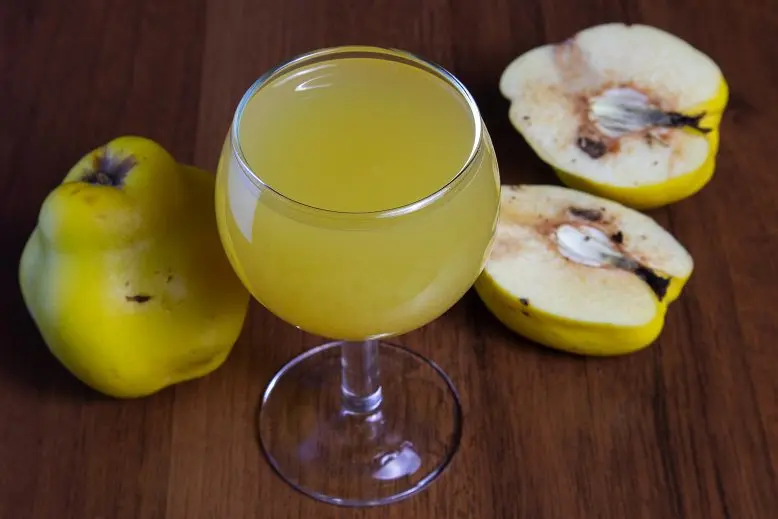Quince is a close relative of apples and pears, but due to its tart taste (an excess of tannins affects) and low sugar content, it is rarely used in winemaking, a special approach is needed here. We will consider the complete technology for making homemade quince wine from working with fruits to filling bottles. The recipe is simple, the main thing is to observe proportions and consistency. The result is a drink with a light aroma of raw materials and an unusual aftertaste.
Suitable ripe ordinary or Japanese quince. First, you should carefully sort out the raw materials, removing spoiled, moldy and rotten parts, but do not wash them so that wild yeast remains on the skin, due to which the juice will ferment. Dirty quince can be wiped with a clean, dry cloth. Sterilize all used containers and tools with boiling water. Handle juice only with clean hands. These precautions will protect against mold and other pathogens.
Ingredients:
- quince fruits – 10 kg;
- water – 0,5 liters;
- sugar – 0,5 kg first and another 250 grams per liter of juice;
- citric acid – 7 grams per liter of juice.
Water is required to reduce the concentration of tannins, due to which the pulp is very tart. Citric acid stabilizes the acidity of the wort, which contributes to normal fermentation and increases the shelf life of the finished drink.
Quince wine recipe
1. Cut the unwashed quince in half, be sure to remove the ponytails, core and seeds from the fruits. These parts contain oils and mucus, which deteriorate the quality.
If the pits and core are not removed, the wine will turn out bitter and viscous.
2. Grate the pulp along with the peel on the smallest grater.
3. Fold the resulting mass into an enameled or plastic container with a wide neck (bucket, bowl, pan). Separately dissolve 0,5 kg of sugar in cold, unboiled water (0,5 liters). Pour the syrup into the grated quince, mix.
4. Cover the container with gauze or a thick cloth to protect against insects. Transfer the wort to a dark place at room temperature. Leave for 3 days.
Every 8-12 hours, mix with a clean hand or a wooden stick, drowning in the liquid the pulp that has floated to the surface – particles of the skin and pulp.
During the first day, signs of fermentation should appear: foam on the surface, hissing, a slight smell of sour.
5. Filter the wort through gauze or cloth. Squeeze the pulp well (you can use a press) to get as much pure juice as possible. No squeezes needed.
6. Add all the citric acid and 150 grams of sugar per 1 liter to the fermented juice. Mix.
7. Pour the wort into a fermentation tank, filling up to a maximum of 75% of the volume to leave room for foam. Install a water seal of any design (you can use a medical glove with a hole pierced by a needle in one of the fingers).

8. Transfer the container with future quince wine to a dark room with a stable temperature of 18-27°C.
9. 5 days after the installation of the water seal, add 50 grams of sugar per liter of juice. To do this, remove the water lock, drain 300-400 ml of wort through a tube, dilute sugar in it, pour the resulting syrup into a fermentation tank and close it again with a water lock.
After 5 days, repeat the procedure for adding sugar (50 grams per liter) according to the technology described above.
Depending on the temperature and yeast activity, homemade quince wine ferments for 25-55 days, then the water seal stops emitting carbon dioxide (the glove deflates), the drink brightens, and a layer of loose sediment is visible at the bottom.
If fermentation has not ended after 50 days from the start of preparation, the wine must be poured into another container without touching the sediment, otherwise bitterness may appear.
10. Drain the fermented wine from the sediment through a straw. Taste and add more sugar to increase sweetness if desired. It can also be fixed with alcohol or vodka (2-15% by volume).
11. Pour the wine into a container for maturation (preferably fill to the top so that there is no contact with oxygen). Close hermetically, if sugar was added at the previous stage, keep under a water seal for the first 7-10 days.
12. Transfer the containers to a refrigerator or cellar at 6-16°C for at least 4-6 months to mature to improve the taste. When a sediment layer of 2-5 cm appears (at first once every 10-15 days, then less often), filter by pouring through a straw.
13. Quince wine is ready when no more sediment appears. The drink can be bottled for storage. Shelf life – up to 3 years. Fortress – 10-12%.










